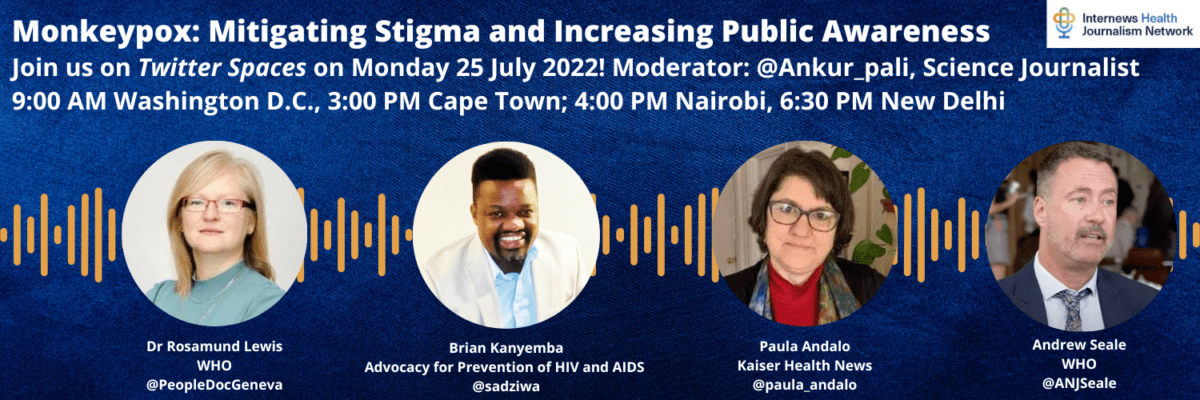by Bea Spadacini

The language we use to describe a disease and how it spreads has the power to set the stage for how people react and cope with a new health threat. This is especially true if the data indicates that a specific community appears to be more susceptible to the disease.
We have seen this play out before in the early years of HIV/Aids and are reliving a similar scenario with monkeypox, a viral disease that is transmitted from one person to another by close contact with lesions, body fluids, respiratory droplets, and contaminated materials. Initial data suggests that monkeypox is spreading faster in the LGBTQ+ community but emphasizing this can be misleading and dangerous.
So much so that on July 24 the World Health Organization (WHO) declared monkeypox a public health emergency of international concern. By the third week of August, the Centers for Disease Control and Prevention (CDC) tracked over 41,000 cases worldwide. Most of these are appearing for the first time outside of a handful of central African nations where the disease was considered endemic.
Framing Messages through a Human Rights Lens
Monkeypox is closely related to smallpox and produces similar symptoms. “This is not a new disease, which makes it harder to grapple with it and understand what the real meaning is,” said Dr. Rosamund Lewis, WHO Technical Lead for Monkeypox, during a Twitter Spaces event organized by the HJN after the official declaration. By flagging this, “We make recommendations to our Member States and ask them to take specific actions framed in a human rights context.”
Communicating about health risks through a human rights lens is especially important for journalists and other media professionals. What does this mean exactly? It entails being aware that words can fuel unfounded beliefs, which can backfire and hurt people. Forty years after HIV/Aids was first detected, the world is grappling with another disease that has the potential to foster discrimination among already vulnerable populations, who are all too often criminalized in many countries around the world.
“Misinformation about HIV led to common beliefs about people living with the condition, which had no scientific basis, but were used to fuel stigma and discrimination,” said Brian Kanyemba, Managing Director and Technical Advisor at the Advocacy for Prevention of HIV and AIDS (APHA).
Kanyemba recalled reading a story in The New York Times, shortly after the CDC published an article in 1981 on HIV mortality and morbidity rates among gay men in Los Angeles, that referred to HIV as, “GRID or Gay Related Immune Deficiency. The change to AIDS or Acquired Immune Deficiency Syndrome did not change the labeling or Aids being linked to homosexual, queer, or gay sexual practices.”
Ankur Paliwal, an independent science journalist in India and the facilitator of the HJN Spaces event, emphasized that, “How we talk about a disease and who is at higher risk will impact to what extent and how vulnerable communities can even talk about it openly. As a gay person myself, this issue is personal to me and my people.”
Viruses do not discriminate
Stigma can affect how people access care and how comfortable they are seeking help. “Viruses are the most democratic entities. They can infect anybody no matter the color of their skin, or their ethnicity or gender,” said Paula Andalo, Ethnic Media Editor at Kaiser Health News, and author of El Virus Mediático: Cómo el VIH irrumpió en la prensa y cambió las reglas (The Media Virus: How HIV Broke into the Press and Changed the Rules). “Social stigma, and medical stigma, put people at risk on many levels, including lack or delayed access to health care services.”
Andy Seale, WHO Strategies Advisor for Global HIV, Hepatitis & STI programs, underscored the complex nature of diseases, how they impact different population groups, and the need for targeted messages. “When it comes to the language for monkeypox,” he said during the discussion, “I think we need to stick to the facts and the science. Sometimes, I see a thoughtful article that goes into the right amount of detail then, sadly, a headline is placed on it that seeks to summarize what is happening. When looking for short cuts, we can suddenly find ourselves using language that is either racist or homophobic.”
Language Matters. Headlines Matter.
Paliwal shared two examples of highly problematic headlines on monkeypox he came across in the Indian media. “One is, Monkeypox is Spreading through Gay Sex. Let that sink in. The second one, 98% Monkeypox Patients are Gay or Bisexual Men.” These headlines, Paliwal said, create fear of being outed among the LGBTQ+ community and impact the decision to seek care. So, “How do we help shape narratives that are accurate, contextualized, respectful and that not stigmatize the gay community?”
Based on his experience with HIV/Aids research and advocacy, Kanyemba suggests focusing on three strategies to mitigate stigma when managing Monkeypox: educate health care professionals, involve the community from the get-go, and invest in vaccine literacy. Finally, he added, “Journalists must emphasize that anyone who comes in contact with a person with an active Monkeypox infection can be at the risk of becoming infected, no matter their sexual orientation.”
Listen the fully recorded HJN Twitter Spaces conversation.
Additional Resources:
Reporting on Monkeypox: https://healthjournalism.internews.org/resource/one-health-toolkit-reporting-on-monkeypox/
Monkeypox Outbreak 2022: https://www.who.int/emergencies/situations/monkeypox-oubreak-2022
Global AIDS Update 2022: https://www.unaids.org/en/resources/documents/2022/in-danger-global-aids-update